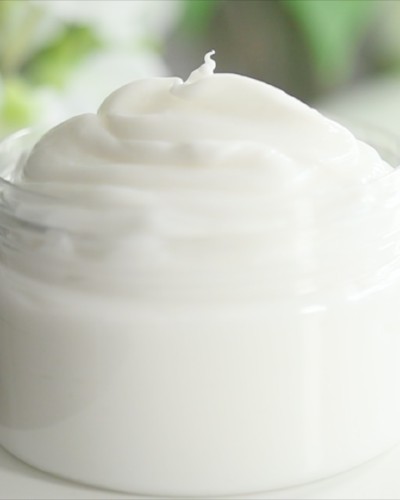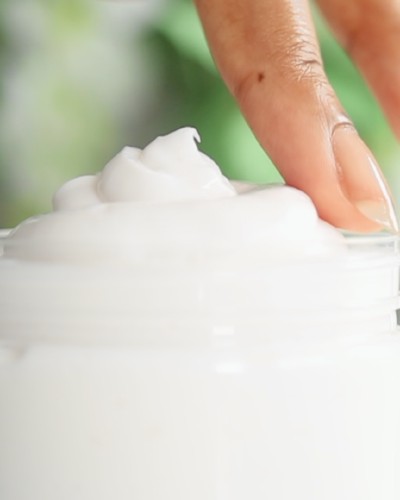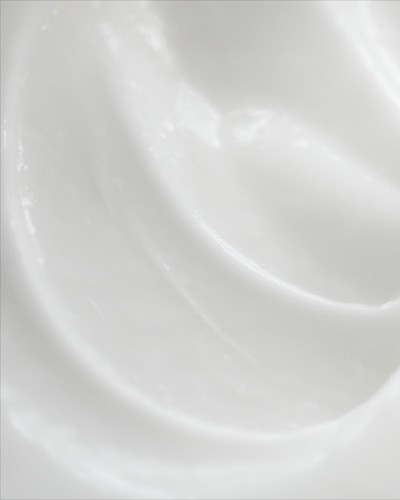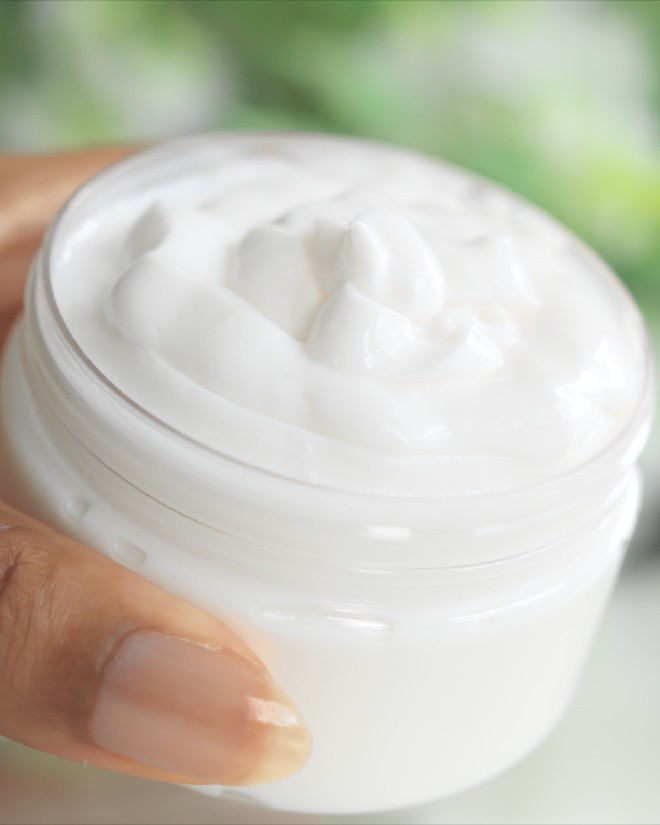An all natural, non-comedogenic, oil-free, anti-inflammatory face moisturiser, perfect for sensitive & acne-prone skin!
Ingredients
Water Phase
- 216g Distilled Water
- 3g Aloe Vera Concentrate
- 6g Glycerine
Oil Phase
- 30g Shea Butter
- 24g Olivem 1000 Emuslifying Wax
Cool Down
- 15g Hyaluronic Acid Gel
- 6g Green Tea Extract
- 3g Preservative Eco
Method
- Measure out your water phase ingredients: Distilled Water, Aloe Vera Concentrate and Glycerine, as well as your oil phase ingredients: Shea Butter and Olivem 1000.
- Gently melt both phases in separate heatproof containers over low heat using a double boiler or bain-marie.
- Once both phases are molten, pour the oil phase into the water phase, whisking thoroughly and transferring to a flat surface.
- Use an immersion blender to create your emulsion, alternate between blending and cooling until a cream starts to form. As the mixture cools, it will start to thicken and change to resemble a thick cream.
- When you are happy with the consistency, and the cream has reached room temperature, you can move on to the cool down phase.
- Measure out your cool down ingredients: Hyaluronic Acid gel, Green Tea extract and Preservative of choice. Mix these ingredients into the cream until thoroughly incorporated.
- At this point you could add essential or fragrance oils for a scented face cream, but check any fragrance is hypoallergenic and non-comedogenic to keep this moisturiser suitable for acne-prone skin types.
- Store your face moisturiser in a tub or pump-style container for ease of use.
This makes 300g of non-comedogenic face moisturiser, and will last for approximately 6 months. See the formula calculator to adjust amounts.

Face moisturiser for sensitive & acne-prone skin
Finding the right moisturiser isn’t easy! Oftentimes, natural moisturisers aren’t always conducive to sensitive, combination and oily skin types - in fact, oils and butters can be a big factor causing irritation. Fortunately, when you make products yourself you can create the perfect cocktail of ingredients to work for your skin.
This face moisturiser is non-comedogenic, anti-inflammatory and oil-free, designed specifically with acne-prone, sensitive skin types in mind! I’ve formulated this recipe to reduce the likelihood of flare-ups, but please do remember to patch test any new recipe to check for ingredient sensitivity and allergies.
Why use oil-free moisturisers?
Oils are some of the best natural moisturisers around - so the notion of an “oil-free” moisturiser might seem a little counterproductive.
However, for many, oils can also be a cause of irritancy. Be it due to allergies, sensitivity, or a preference for lighter moisturisers, and that’s where oil-free moisturisers come in!

Benefits of oil-free moisturisers
- Great for oily and combination skin: oil-free moisturisers work in conjunction with your natural sebum, helping to balance your skin and prevent excess oil
- Don’t clog pores: oil-free moisturisers are often non-comedogenic, reducing the likelihood of acne and flareups
- Soothing and anti-inflammatory: oil-free moisturisers usually contain a wider variety of minerals, vitamins and botanical extracts such as aloe vera and clays, to boost their moisturising potential
- Lighter, more absorbent moisturisers: oils tend to feel heavier and take longer to absorb into the skin, giving oil-free moisturisers a unique “weightless” application
In addition to the benefits above, a major advantage of oil-free moisturisers is that they’re often non-comedogenic.
What is non-comedogenic?

Comedogenic refers to substances that potentially clog or block your pores, often resulting in “comedones” (a type of acne). Ingredients labelled “non-comedogenic” are less likely to cause irritation, flareups or acne as they don’t block pores.
Certain oils have the potential to clog pores and therefore, oil-free moisturisers are usually non-comedogenic. But this is not a hard and fast rule! Oils, fatty alcohols, emulsifiers and extracts can all potentially have comedogenic properties, so unless a moisturiser explicitly states that it is non-comedogenic, assume that it may have potentially irritating ingredients.
The Comedogenic Rating
Many cosmetic ingredients went through a “rabbits ear test” to determine their comedogenic rating, this resulted in a scale to indicate the likeliness of clogging pores. The Comdeogenic rating assigns a rating from 0 to 5, with zero being non-comedogenic and five being the more severely comedogenic. It’s important to note that this scale isn’t standardised and many ingredients have conflicting ratings depending on the source. It is however, a useful tool to keep in mind when trying to avoid potentially irritating or acne-inducing products.
In addition to individual ingredients being comedogenic, the amount present in a formula can also affect how comedogenic a moisturiser is. For this face moisturiser I’ve chosen to use shea butter which has a comedogenic rating of 0, as well as Olivem 1000 which is also considered non-comedogenic with a rating of 1.
Substitutions
For a lighter, oil-free alternative to shea butter, you can substitute it with the ester Caprylic / Capric Triglyceride.
For an all natural, no-butter moisturiser, Squalane has a comedogenic rating of 0.
